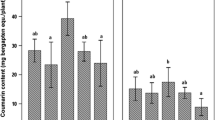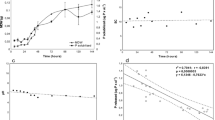Abstract
The interactions between the mycorrhizal fungusGlomus mosseae, the plant pathogenPythium ultimum, and a pathogen-antagonistTrichoderma aureoviride in the rhizosphere ofTagetes erecta (marigold) were studied for their effects on plant growth in a peat-perlite substrate. Mycorrhizal fungus inoculation protected the plant againstP. ultimum, since both phytomass production and foliar development were higher in mycorrhizal plants.T. aureoviride had no effect on nonmycorrhizal plants in the presence or absence ofP. ultimum. However, more biomass was produced by mycorrhizal plants whenT. aureoviride was present, whether or not soil was infested withP. ultimum. ei]R Rodriguez-Kabana
Similar content being viewed by others

References
Azcón R, Barea J M and Hayman D S 1976 Utilization of rock phosphate in alkaline soils by plants inoculated with mycorrhizal fungi and phosphate solubilizing bacteria. Soil Biol. Biochem. 8, 135–138.
Azcón-Aguilar C and Barea J M 1985 Effect of soil microorganisms on formation of vesicular-arbuscular mycorrhizas. Trans. Br. Mycol. Soc. 84, 536–537.
Baker R 1989 ImprovedTrichoderma spp. for promoting crop productivity. Trends Biotechnol. 7, 34–38.
Barea J M, Bonis A F and Olivares J 1983 Interactions betweenAzospirillum and VA mycorrhiza and their effect on growth and nutrition of maize and ryegrass. Soil Biol. Biochem. 15, 705–709.
Bowen G D and Theodorou C T 1979 Interactions between bacteria and ectomycorrhizal fungi. Soil Biol. Biochem. 11, 119–126.
Calvet C, Pera J and Barea J M 1990 Interactions ofTrichoderma spp. withGlomus mosseae and two wilt pathogenic fungi. Agric. Ecosyst. Environ. 29, 59–66.
Calvet C, Barea J M and Pera J 1992 In vitro interactions between the vesicular-arbuscular mycorrhizal fungusGlomus mosseae and some saprophytic fungi isolated from organic substrates. Soil Biol. Biochem. 24, 775–780.
Cook R J and Baker K F 1983 The Nature and Practice of Biological Control of Plant Pathogens. The American Phytopathological Society, St. Paul, MN. 539 p.
Davet P, Artiques M and Martin C 1981 Production en conditions non aseptiques d'inoculum deTrichoderma harzianum Rifai pour des essais de lutte biologique. Agronomie 1, 933–936.
Davey C B 1971 Nonpathogenic organisms associated with mycorrhizae.In Mycorrhizae. Ed. X Hacskaylo, USDA Miscellaneous Publication 1189. 255 p.
Dennis C and Webster J 1971 Antagonistic properties of species-groups ofTrichoderma. I. Production of non volatile antibiotics. Trans. Br. Mycol. Soc. 57, 41–48.
DeOliveira V L, Bellei M M and Borges A C 1984 Control of white rot of garlic by antagonistic fungi under controlled environmental conditions. Can. J. Microbiol. 30, 884–889.
DeOliveira V L and Garbaye J 1989 Les microorganismes auxiliaires de l'établissement des symbioses mycorrhiziennes. Eur. J. For. Pathol. 17, 54–64.
Garbaye J and Bowen G D 1987 Effect of different microflora on the success of ectomycorrhizal inoculation ofPinus radiata. Can. J. For. Res. 17, 941–943.
Garcia-Garrido J M and Ocampo J A 1989 Effect of VA-mycorrhizal infection of tomato on damage caused byPseudomonas syringae. Soil Biol. Biochem. 21, 165–167.
Giovannetti M and Mosse B 1980 An evaluation of techniques for measuring vesicular-arbuscular mycorrhizal infections in roots. New Phytol. 84, 489–500.
Henis Y, Elad Y, Chet I, Hadar I and Hadar E 1979 Control of soil plant pathogenic fungi in carnation, strawberry and tomato byTrichoderma harzianum. Phytopathology, 69, 1031.
Hwang S F 1988 Effects of mycorrhizae and metalaxyl on growth of alfalfa seedlings in soils from fields with ‘alfalfa sickness’ in Alberta. Plant Dis, 72, 448–451.
Krishna K R, Balakrishna A N and Bagyaraj D J 1982 Interactions between a vesicular-arbuscular mycorrhizal fungus andStreptomyces cinnamomeous and their effects on finger millet. New Phytol. 92, 401–405.
Kuter G A and Hoitink H A J 1985 Use of combinations of microbial antagonists to suppressRhizoctonia andPythium damping-off in compost-amended media. Phytopathology 75, 1344.
Kwok O C H, Fahy P C, Hoitink H A J and Kuter G A 1987 Interactions between bacteria andTrichoderma hamatum in suppression ofRhizoctonia damping-off in bark compost media. Phytopathology 77, 1206–1212.
Linderman R G 1988 Mycorrhizal interactions with the rhizosphere microflora: The mycorrhizosphere effect. Phytopathology 78, 366–371.
Meyer J R and Linderman R G 1986 Response of subterranean clover to dual inoculation with vesicular-arbuscular mycorrhizal fungi and a plant growth promoting bacteriurnPseudomonas putida. Soil Biol. Biochem. 18, 185–190.
Nelson E B and Hoitink H A J 1983 The role of microorganisms in the suppression ofRhizoctonia solani in container media amended with composted hardwood bark. Phytopathology 73, 274–278.
Pera J and Calvet C 1989 Suppression ofFusarium wilt or carnation in a composted pine bark and a composted olive pumice. Plant Dis. 73, 699–700.
Perrin R 1991 Mycorrhizes et protection phytosanitaire.In Les mycorrhizes des arbres et plantes cultivées. Ed. D GStrullu, pp 93–130. Technique et Documentation Lavoisier, Paris.
Phillips J M and Hayman D S 1970 Improved procedures for clearing roots and staining parasitic and vesicular-arbuscular mycorrhizal fungi for rapid assessment of infection. Trans. Br. Mycol. Soc. 55, 158–161.
Summerbell R C 1987 The inhibitory effect ofTrichoderma species and other soil microfungi on formation of mycorrhiza byLaccaria bicolor in vitro. New Phytol, 105, 437–448.
Sylvia D M and Schenck N C 1983 Germination of chlamydospores of threeGlomus species as affected by soil matric potential and fungal contamination. Mycologia 75, 30–35.
Trillas-Gay M I, Hoitink H A J and Madden L V 1986 Nature of suppression ofFusarium wilt of radish in a container medium amended with composted hardwood bark. Plant Dis. 70, 1023–1027.
Author information
Authors and Affiliations
Rights and permissions
About this article
Cite this article
Calvet, C., Pera, J. & Barea, J.M. Growth response of marigold (Tagetes erecta L.) to inoculation withGlomus mosseae, Trichoderma aureoviride andPythium ultimum in a peat-perlite mixture. Plant Soil 148, 1–6 (1993). https://doi.org/10.1007/BF02185378
Received:
Accepted:
Issue Date:
DOI: https://doi.org/10.1007/BF02185378



